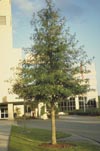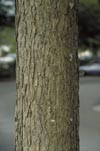Home >
Quercus austrina, Bluff Oak
Bluff Oak is native to the deep south along the coastal plain. It grows quite large in the woods with trunks up to 4 feet in diameter. Landscape trees have not grown to this size because the tree has not been planted as a landscape tree for more than about 50 years. Open grown trees should be pruned early in their life to space branches along the central trunk. The largest diameter branches should be at least 18 to 24 inches apart to allow each one to secure themselves to the tree. Closer spacing cold lead to branches splitting from the tree. The tree has good drought tolerance but should be planted only in acid soil. Its tolerance to alkaline soil has not been well tested.
Bluff Oak should be grown in full sun on well-drained soil, and has good drought-tolerance. It also positions itself along side stream banks where it is periodically flooded. It is well suited for planting in parking lots or along streets and boulevards where there is plenty of space for crown development. It grows well in urban landscapes because if their tolerance to both drought and wet soil. The tree compartmentalizes decay resulting from injury very well.
A row of Bluff Oaks planted on 30 foot centers in Gainesville, Florida (hardiness zone 8b) makes a wonderful site along the edge of a parking lot. The medium-textured leaves make this oak stand out from other oaks. Upright to horizontal branching habit make this an easy tree to prune for vehicular clearance beneath the canopy.
Often
found along stream banks with red maple and elms and black gum in its
native habitat so it tolerates periodic flooding. Can develop a tap root
in well-drained soil. Oak wood is considered ring porous to semi-ring
porous. Oaks serve as larvae host plants for the brown duskywing butterfly
(Erynnis horatius) and the gray hairstreak (Strymon melinus).






